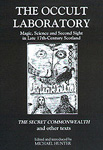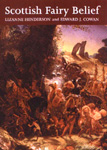Fairies and Folk
In the repertoire of traditional Gaelic beliefs, second sight is undoubtedly the most dominating of them all. It is not merely a matter of giving credence to this distinctive kind of clairvoyance:the belief also organises and validates other ‘superstitions’, among them attitudes to belief in the existence of the Sidhichean (very inadequately rendered in English as the Fairies). The Sidhichean may not be visible to us now, but in the past, it is sometimes argued, people must have possessed a faculty – some kind of second sight – that enabled them to see and even converse with them. In some instances this is a defensive rationalisation as if to say:it would be absurd to claim we believe in fairies, not so absurd to suggest that different forms of precognition may exist. But the records of earlier ages demonstrate clearly that the connection between fairies and second sight is an old and firmly established one.
Nowhere is this set forth with greater vividness than in The Secret Commonwealth of Elves, Faunes and Fairies, written in 1691 by the Reverend Robert Kirk, minister of Balquidder at Aberfoyle and an accomplished Gaelic scholar. Kirk has sometimes been regarded as a maverick clergyman, holding opinions that ran counter to those of orthodox Christianity. But given what we know about Gaelic tradition we can be pretty sure most of his co-religionists would subscribe to the same beliefs even if they did not analyse them in quite the same way, nor express them with such ministerial authority.
Briefly stated, Kirk held that human beings possess body and soul, as the church teaches, but there is also a third component, a sort of ‘astral self.’ This is entirely in line with Gaelic tradition, which places much emphasis on the reality of the doppelganger or ‘fetch’ of the living. In Kirk’s system, however firmly based on received information, these apparitions or resemblances are assimilated, in whole or in part, to manifestations of fairy beings and are visible only to those who possess the gift of second sight. Yet at the same time he describes a society of fairies which is not merely composed of such ‘resemblances’ but exists as it were in its own right. When a person dies, his or her ‘resemblance’ rejoins this community in the Sidhean, the Fairy Knoll. Kirk is obviously both traditionalist and innovator.
Kirk’s manuscript was not published until 1815, and even then, only from a defective copy. Reprinted in 1893, this was published again in 1933. In 1976 Stewart Sanderson edited the first complete edition from a manuscript in Edinburgh University Library. We now have a new edition,  The Occult Laboratory:Magic, Science and Second Sight in Late 17th-Century Scotland (Boydell Press, 0 85115 801 3), edited and introduced by Michael Hunter. This immensely detailed study presents a series of interconnected texts dating from the last twenty years of the seventeenth century, the common theme of which is second sight. Among these are James Garder’s letters to John Aubrey, Samuel Pepys’s collection of letters on second sight, and the Reverend John Fraser’s Deuteroscopia (Greek for second sight). The editor, Professor Michael Hunter, supplies detailed notes on all the texts and a long introductory essay which provides invaluable information on Kirk’s imaginative and theological position viewed against the intellectual background of his own age. For anyone who is at all interested in these cultural phenomena, this is an indispensable work of scholarship.
The Occult Laboratory:Magic, Science and Second Sight in Late 17th-Century Scotland (Boydell Press, 0 85115 801 3), edited and introduced by Michael Hunter. This immensely detailed study presents a series of interconnected texts dating from the last twenty years of the seventeenth century, the common theme of which is second sight. Among these are James Garder’s letters to John Aubrey, Samuel Pepys’s collection of letters on second sight, and the Reverend John Fraser’s Deuteroscopia (Greek for second sight). The editor, Professor Michael Hunter, supplies detailed notes on all the texts and a long introductory essay which provides invaluable information on Kirk’s imaginative and theological position viewed against the intellectual background of his own age. For anyone who is at all interested in these cultural phenomena, this is an indispensable work of scholarship.
Robert Kirk is predictably one of the key figures in Scottish Fairy Belief, an examination of the nature, growth and development of the ‘fairy faith’ by two professional historians. Although there are inevitable overlaps between their work and Hunter’s study of fairies and second sight, these two books are completely different in perspective and serve quite different ends. In Henderson and Cowan there is almost throughout a focus on witchcraft (see especially chapter four, ‘The Rise of the Demonic’) and on witch hunts and witch trials. This is justified because of the fascinating intersections that exist between the world of the witches (much of the evidence for that of course having been extracted under torture) and the world of the fairies.
 For their purposes, the whole of Scotland is assumed to be one homogeneous area, culturally speaking. The Sidhichean of Gaelic and the fairies of the Lowlands are apparently identical beings:whereas, it is implied, English fairies are not. The seers of Gaelic tradition, not to mention social anthropologists, might well draw other lines of demarcation. Nonetheless, it is quite true, from a simple ethnographic point of view, that Highland and Lowland fairy legends have much in common. So far as witchcraft is concerned, though, the authors do acknowledge the existence of certain differences in social attitudes:’While trials did take place in Gaelic-speaking regions, witch panics were fewer though the precise reasons for this are unknown. It is possible that Gaelic society enjoyed a higher level of toleration of the occult and so managed to retain a certain level of acceptance
For their purposes, the whole of Scotland is assumed to be one homogeneous area, culturally speaking. The Sidhichean of Gaelic and the fairies of the Lowlands are apparently identical beings:whereas, it is implied, English fairies are not. The seers of Gaelic tradition, not to mention social anthropologists, might well draw other lines of demarcation. Nonetheless, it is quite true, from a simple ethnographic point of view, that Highland and Lowland fairy legends have much in common. So far as witchcraft is concerned, though, the authors do acknowledge the existence of certain differences in social attitudes:’While trials did take place in Gaelic-speaking regions, witch panics were fewer though the precise reasons for this are unknown. It is possible that Gaelic society enjoyed a higher level of toleration of the occult and so managed to retain a certain level of acceptance
…’
In this connection it is worth adding that the common words for ‘witch’ and its conquerors in Scots Gaelic are borrowed from English. This is highly suggestive and at least hints at the introduction of new forms of divination and enchantment, possibly supplanting native institutions in which women were powerful shamans.
Copyright John MacInnes 2005.

Dunizell on Tue, 26th Jul 2011 7:53 pm
^_^ I’m so glad that someone other then myself likes this stuff
Alastair McIntosh on Sat, 7th Nov 2015 2:51 pm
Don’t worry, I like it too!